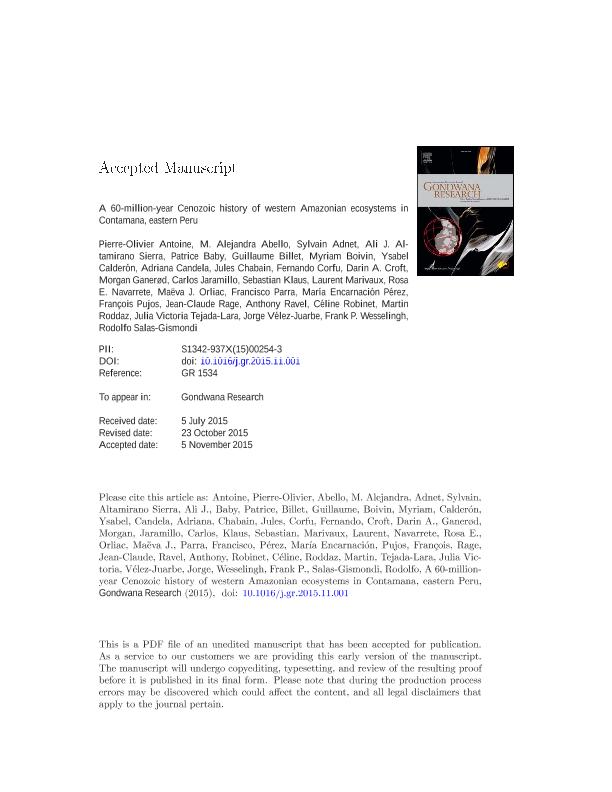Artículo
A 60-million-year Cenozoic history of western Amazonian ecosystems in Contamana, eastern Peru
Antoine, Pierre Olivier; Abello, María Alejandra ; Adnet, Sylvain; Altamirano Sierra, Ali J.; Baby, Patrice; Billet, Guillaume; Boivin, Myriam
; Adnet, Sylvain; Altamirano Sierra, Ali J.; Baby, Patrice; Billet, Guillaume; Boivin, Myriam ; Calderón, Ysabel; Candela, Adriana Magdalena
; Calderón, Ysabel; Candela, Adriana Magdalena ; Chabain, Jules; Corfu, Fernando; Croft, Darin; Ganerød, Morgan; Jaramillo, Carlos; Klaus, Sebastian; Marivaux, Laurent; Navarrete, Rosa E.; Orliac, Maeva Judith; Parra, Francisco; Pérez, María Encarnación
; Chabain, Jules; Corfu, Fernando; Croft, Darin; Ganerød, Morgan; Jaramillo, Carlos; Klaus, Sebastian; Marivaux, Laurent; Navarrete, Rosa E.; Orliac, Maeva Judith; Parra, Francisco; Pérez, María Encarnación ; Pujos, François Roger Francis
; Pujos, François Roger Francis ; Rage, Jean-Claude; Ravel, Anthony; Robinet, Celine
; Rage, Jean-Claude; Ravel, Anthony; Robinet, Celine ; Roddaz, Martin; Tejada Lara, Julia Victoria; Vélez Juarbe, Jorge; Wesselingh, Frank P.; Salas Gismondi, Rodolfo
; Roddaz, Martin; Tejada Lara, Julia Victoria; Vélez Juarbe, Jorge; Wesselingh, Frank P.; Salas Gismondi, Rodolfo
 ; Adnet, Sylvain; Altamirano Sierra, Ali J.; Baby, Patrice; Billet, Guillaume; Boivin, Myriam
; Adnet, Sylvain; Altamirano Sierra, Ali J.; Baby, Patrice; Billet, Guillaume; Boivin, Myriam ; Calderón, Ysabel; Candela, Adriana Magdalena
; Calderón, Ysabel; Candela, Adriana Magdalena ; Chabain, Jules; Corfu, Fernando; Croft, Darin; Ganerød, Morgan; Jaramillo, Carlos; Klaus, Sebastian; Marivaux, Laurent; Navarrete, Rosa E.; Orliac, Maeva Judith; Parra, Francisco; Pérez, María Encarnación
; Chabain, Jules; Corfu, Fernando; Croft, Darin; Ganerød, Morgan; Jaramillo, Carlos; Klaus, Sebastian; Marivaux, Laurent; Navarrete, Rosa E.; Orliac, Maeva Judith; Parra, Francisco; Pérez, María Encarnación ; Pujos, François Roger Francis
; Pujos, François Roger Francis ; Rage, Jean-Claude; Ravel, Anthony; Robinet, Celine
; Rage, Jean-Claude; Ravel, Anthony; Robinet, Celine ; Roddaz, Martin; Tejada Lara, Julia Victoria; Vélez Juarbe, Jorge; Wesselingh, Frank P.; Salas Gismondi, Rodolfo
; Roddaz, Martin; Tejada Lara, Julia Victoria; Vélez Juarbe, Jorge; Wesselingh, Frank P.; Salas Gismondi, Rodolfo
Fecha de publicación:
03/2016
Editorial:
Elsevier Science
Revista:
Gondwana Research
ISSN:
1342-937X
Idioma:
Inglés
Tipo de recurso:
Artículo publicado
Clasificación temática:
Resumen
We provide a synopsis of ~. 60 million years of life history in Neotropical lowlands, based on a comprehensive survey of the Cenozoic deposits along the Quebrada Cachiyacu near Contamana in Peruvian Amazonia. The 34 fossil-bearing localities identified have yielded a diversity of fossil remains, including vertebrates, mollusks, arthropods, plant fossils, and microorganisms, ranging from the early Paleocene to the late Miocene-?Pliocene (>. 20 successive levels). This Cenozoic series includes the base of the Huchpayacu Formation (Fm.; early Paleocene; lacustrine/fluvial environments; charophyte-dominated assemblage), the Pozo Fm. (middle + ?late Eocene; marine then freshwater environments; most diversified biomes), and complete sections for the Chambira Fm. (late Oligocene-late early Miocene; freshwater environments; vertebrate-dominated faunas), the Pebas Fm. (late early to early late Miocene; freshwater environments with an increasing marine influence; excellent fossil record), and Ipururo Fm. (late Miocene-?Pliocene; fully fluvial environments; virtually no fossils preserved). At least 485 fossil species are recognized in the Contamana area (~. 250 'plants', ~. 212 animals, and 23 foraminifera). Based on taxonomic lists from each stratigraphic interval, high-level taxonomic diversity remained fairly constant throughout the middle Eocene-Miocene interval (8-12 classes), ordinal diversity fluctuated to a greater degree, and family/species diversity generally declined, with a drastic drop in the early Miocene. The Paleocene-?Pliocene fossil assemblages from Contamana attest at least to four biogeographic histories inherited from (i) Mesozoic Gondwanan times, (ii) the Panamerican realm prior to (iii) the time of South America's Cenozoic "splendid isolation", and (iv) Neotropical ecosystems in the Americas. No direct evidence of any North American terrestrial immigrant has yet been recognized in the Miocene record at Contamana.
Palabras clave:
FOSSIL RECORD
,
PALEOBIOLOGY
,
PALEOGEOGRAPHY
,
SOUTH AMERICA
,
STRATIGRAPHY
Archivos asociados
Licencia
Identificadores
Colecciones
Articulos(CCT - LA PLATA)
Articulos de CTRO.CIENTIFICO TECNOL.CONICET - LA PLATA
Articulos de CTRO.CIENTIFICO TECNOL.CONICET - LA PLATA
Articulos(IANIGLA)
Articulos de INST. ARG. DE NIVOLOGIA, GLACIOLOGIA Y CS. AMBIENT
Articulos de INST. ARG. DE NIVOLOGIA, GLACIOLOGIA Y CS. AMBIENT
Articulos(SEDE CENTRAL)
Articulos de SEDE CENTRAL
Articulos de SEDE CENTRAL
Citación
Antoine, Pierre Olivier; Abello, María Alejandra; Adnet, Sylvain; Altamirano Sierra, Ali J.; Baby, Patrice; et al.; A 60-million-year Cenozoic history of western Amazonian ecosystems in Contamana, eastern Peru; Elsevier Science; Gondwana Research; 31; 3-2016; 30-59
Compartir
Altmétricas



